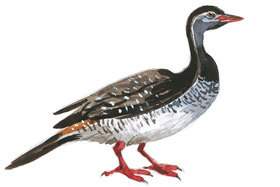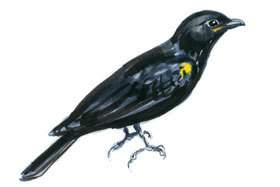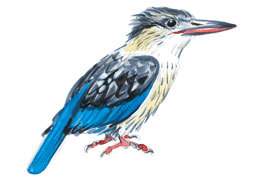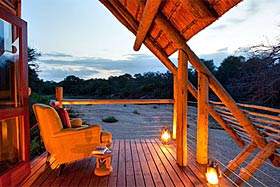
The Skukuza area is situated in the Sabie River catchment system, which is a magnet for woodland birds. The Sabie is the only river in Kruger that reliably flows all year round, which means that game densities here are among the highest in the Park.
Birding Map for Kruger Parks' Skukuza and Surrounding Area

Habitat Pointers
Mixed Knob-thorn Acacia and Marula rolling woodlands with Magic Guarri, Sickle-bush and Leadwoods; thorn thickets around Skukuza and along the lower contours of the Sabie River catchment area; large gallery forests along the river's edge.
The birdlife is rich and the Sabie acts as an arterial route for many altitudinal migrants that visit the lowveld from the escarpment. The riverine bush to the west of Skukuza is more dense than to the east, which was radically affected by the floods of 2000. Many old trees were swept away and the sandbank pattern has changed.
How this has altered the birdlife of the river will become clearer over time. There are still established stands of Ebony Jackal-berry, Weeping Boer-bean, Sycamore Figs and Tambotis. Away from the river, there are thorn thickets and mixed woodland interspersed with sweetveld grazing. Dominant trees in the Skukuza area are the Red Bushwillow, Knob-thorn and Marula.
Bushwillows are full of insect life and therefore are associated with insect-eating bird species, particularly when the trees are in summer flower. The Red Bushwillow (Combretum apiculatum) bears heavily-scented, yellow flowers from September to February. Along with the River Bushwillow (Combretum erythrophyllum) and the Forest Croton (Croton sylvaticus) which fruits from December to May, these trees attract Acacia Pied Barbets, African Green-Pigeons, Red-eyed Doves and Trumpeter Hornbills.
 The African Finfoot.
The African Finfoot.
Looks like a Darter when it's in the water, but has unmistakable large, bright orange feet. It is a shy and secretive bird usually found in the quieter pools on the Sabie River.
Look for it in the thicker riverine bush between Skukuza and Lower Sabie and on the river loops off the Salitjie Road.
Black Cuckooshrike (Campephaga flava).
 Black Cuckooshrike. A summer resident in the mixed bushveld around Skukuza. The female is more colourful and cuckoo-like than the male, which is black with small, yellow shoulderpads. Although it is common, it is unobtrusive with a soft trilling call. It often joins birding parties when there is a profusion of insects.
Black Cuckooshrike. A summer resident in the mixed bushveld around Skukuza. The female is more colourful and cuckoo-like than the male, which is black with small, yellow shoulderpads. Although it is common, it is unobtrusive with a soft trilling call. It often joins birding parties when there is a profusion of insects.
 Trumpeter Hornbill (Bycanistes bucinator)
Trumpeter Hornbill (Bycanistes bucinator)
This is a common resident found in small flocks in the riverine bush and mixed woodland near permanent water. It is often found around large, fruiting trees. It is recognisable by the casque on the bill, which appears as if it has a double beak. It has a call that sounds like a primary school pupil practising on the trumpet.
 Striped Kingfisher (Halcyon chelicuti)
Striped Kingfisher (Halcyon chelicuti)
Striped Kingfisher. A small resident and the least colourful of the kingfishers. It prefers insects to fish and is therefore more of a woodland than a river bird. It has a bold, black eye-stripe and red bill with blue, upper-tail feathers only really visible in flight.
It has a wonderful descending call and is most often heard in the late afternoon and early evening in the drier woodlands in the Skukuza area.


